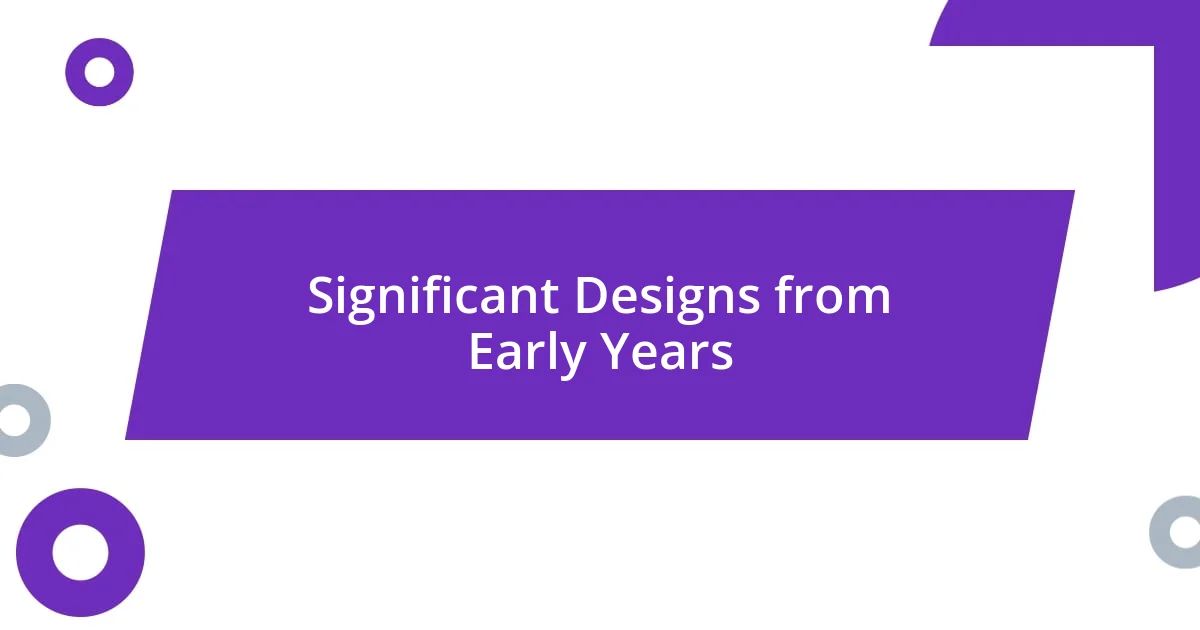Key takeaways:
- The evolution of Bitcoin design reflects its philosophy of decentralization and user accessibility, with early designs prioritizing simplicity and clarity, as seen in the original whitepaper and wallets.
- Art and merchandise in the Bitcoin community serve as crucial tools for self-expression and connection among enthusiasts, exemplified by the “Bitcoin Angel” artwork and branded items that resonate with the culture of cryptocurrency.
- Future trends in Bitcoin design emphasize inclusivity, gamification, and environmental sustainability, aiming to create user-friendly experiences while promoting awareness of ecological impacts in the cryptocurrency space.

Overview of Bitcoin Designs
Bitcoin designs encompass a fascinating blend of aesthetic and functional elements, evolving since its inception. From the minimalist elegance of the original whitepaper to the various graphical representations of blockchain technology, each design reflects the underlying philosophy and culture of Bitcoin. I often find myself marveling at how design choices can influence perceptions — why do some designs resonate more than others?
Take the iconic Bitcoin logo, for instance. Its simplicity is striking, yet it conveys a deep sense of innovation and rebellion against traditional finance—a bit like how I felt when I first learned about Bitcoin. That logo has become a symbol of a movement, representing not just currency, but also freedom and decentralization. Every time I see it, I can’t help but think about what it means to be part of this transformative era.
Moreover, the designs of various Bitcoin wallets and platforms reflect the ongoing evolution of user experience in this digital landscape. I recall the initial confusion I experienced while navigating my first wallet—a jumble of buttons and settings that left me feeling overwhelmed. This experience has shaped my appreciation for more intuitive design approaches that prioritize user accessibility, emphasizing the importance of thoughtful design in making Bitcoin accessible to everyone.

Significant Designs from Early Years
The early designs in Bitcoin history laid the foundation for what we now consider essential elements of its identity. I remember when I first stumbled across the original Bitcoin whitepaper by Satoshi Nakamoto. Its straightforward layout and minimal graphics were a refreshing deviation from the overly complex and cluttered presentations that often bombard us. It invited curiosity rather than intimidation, drawing me in with its clarity. The visual simplicity reflected the revolutionary ideal of Bitcoin: democratization of finance, which had an enormous impact on my understanding of the entire ecosystem.
- The Bitcoin logo was first introduced in 2010, designed by an anonymous individual, and quickly became a universal symbol for the cryptocurrency community.
- The early wallet designs, like Bitcoin-Qt, showcased a simple user interface, marking the first attempt at making Bitcoin accessible.
- Block explorers, such as Blockchain.info, emerged during these formative years, presenting transaction data in a way that engaged users eager to see the blockchain in action.
- The initial exchanges, like Mt. Gox, highlighted a raw, functional design that emphasized trading over user experience, a stark contrast to today’s polished platforms.
Reflecting on these designs, it’s striking how they not only served functional purposes but also communicated the ethos of a burgeoning movement that I, and so many others, felt compelled to be part of.

Innovative Wallet Designs Evolution
The evolution of wallet designs in the Bitcoin space is truly remarkable. I remember my first experience with a wallet app; it was a rugged, almost intimidating interface. Yet, watching wallets morph into sleek, user-friendly applications filled me with excitement. Each update seemed to usher in a new era of accessibility—like when hardware wallets made securing Bitcoin easy and intuitive, allowing even the tech-averse to engage confidently in the ecosystem.
As I explored different wallets, I noticed how design decisions increasingly factored in user behavior and psychology. I vividly recall the day I switched to a wallet that featured color-coded transaction histories; it was like night and day compared to the plain text I was used to. This little tweak transformed how I interacted with my funds and elevated my understanding of transaction patterns. It’s fascinating to see how thoughtful design adjustments can foster a deeper connection to financial assets.
Today, wallet designs continue to innovate, integrating biometric security while focusing on a seamless user interface. I often think about how these advancements not only enhance security but also empower users like me to feel in control of their digital assets. Witnessing this evolution has been a personal journey into the very essence of financial self-sovereignty, making me appreciate the craft behind each wallet design.
| Wallet Design | Key Features |
|---|---|
| Bitcoin-Qt | Simple interface, core functionality |
| Trezor | Hardware safety, user-friendly |
| Mycelium | Mobile focus, advanced features |

Memorable Artwork in Bitcoin Community
One piece of artwork that truly resonates with me is the iconic “Bitcoin Angel.” It’s both whimsical and profound, bringing a touch of humanity to a technology that can often feel cold and technical. The first time I saw it at a conference, I was struck by how this design blended the ethereal with the digital; it felt like a reminder that behind the code, there are people and aspirations. Doesn’t it make you think about how art can be a vessel for emotion in a world filled with numbers?
Then there’s the artistic trend of pixel art that emerged within the community. I remember scrolling through Twitter and stumbling upon a vibrant collection of pixelated Bitcoin logos and characters. Each piece was unique, reflecting diverse perspectives while paying homage to the early days of gaming culture. This style is not just nostalgic but shows how creativity can elevate a simple logo into a beloved emblem of a movement. Can you imagine how this playful aesthetics allows non-technical enthusiasts to engage with Bitcoin more comfortably?
Don’t forget about the various memes that have become a form of digital artwork in their own right. I find myself laughing at the cleverness of these creations, like the “HODL” meme—it’s not just funny; it encapsulates a philosophy. It provides a sense of camaraderie within the community, creating an inside joke that connects individuals across the globe. Isn’t it fascinating how a simple meme can evoke feelings of belonging and shared purpose among such a diverse group of people?

Influential Merchandise and Branding
Merchandise and branding in the Bitcoin space have often been transformative, serving as more than just promotional tools. I still recall the moment I first spotted a Bitcoin-themed hoodie at a conference. Wearing it felt like donning a badge of honor and instantly connected me to other enthusiasts. It’s amazing how a simple design can spark conversations and build community, isn’t it?
The branding of Bitcoin merchandise has evolved to reflect a broader culture surrounding cryptocurrency. For instance, I remember walking through the aisles of a crypto expo, where every booth was adorned with striking visuals and logo-centric swag—stickers, shirts, and mugs emblazoned with clever phrases like “In Crypto We Trust.” Each item seemed to resonate with a shared ethos, encapsulating not just a lifestyle, but a movement. Isn’t it incredible how branding can bridge the gap between technology and everyday life?
What truly stands out to me is how merchandise has become a medium for self-expression among Bitcoin supporters. I once bought a limited-edition art print featuring a Bitcoin representation alongside traditional currency symbols. Hanging it in my office, I felt a sense of pride in blending both worlds—traditional finance and digital innovation. It’s more than just decor; it’s a statement about my values and beliefs. How do you think our choices in merchandise reflect our personal journeys within the crypto universe?

Notable Projects and Collaborations
When I think about the notable collaborations within the Bitcoin sphere, the partnership between artists and developers comes to mind—one standout example being the “Rare Pepes” project. This initiative not only tokenized digital art but also preserved cultural moments within the crypto community. I vividly remember discovering these unique tokens and pondering how they bridged the gap between traditional art forms and blockchain technology. Isn’t it remarkable how a simple collaboration can revolutionize our understanding of ownership in the digital age?
Another fascinating endeavor is the Bitcoin Design Community, which strives to involve designers in enhancing the user experience of Bitcoin wallets and applications. I was genuinely impressed by their commitment to improving accessibility, making the technology more user-friendly for newcomers. It made me realize how essential it is to have diverse voices contributing to the design—after all, what good is innovation if it doesn’t resonate with everyone using it?
Additionally, I’ll never forget the creative synergy that blossomed during the “Bitcoin Creative Jam” held last year. It was a melting pot of minds combining art, technology, and crypto passion, leading to collaborations that shocked and inspired me. Watching artists sketch out ideas for merchandise and software on the fly was not just collaborative but brought to life the idea that creativity fuels innovation. Have you ever experienced a moment where collaboration sparked something truly extraordinary?

Future Trends in Bitcoin Design
As I look ahead, I can’t help but feel excited about the potential for more inclusive and user-friendly Bitcoin design trends. For instance, there’s been a growing focus on minimalist interfaces that remove clutter and emphasize clarity. I remember struggling with convoluted wallet designs when I first dipped my toes into Bitcoin; if only I had had a sleek, intuitive app that felt welcoming instead of overwhelming! Doesn’t it seem like we all deserve that kind of ease when navigating our financial futures?
The future of Bitcoin design also seems to be steering towards gamification, making the experience of using Bitcoin more engaging. During a recent workshop, I watched as developers showcased apps that reward users for learning about Bitcoin through interactive games and challenges. It struck me how blending education with fun could foster a deeper understanding of cryptocurrency. Have you ever found yourself engrossed in an educational game that turned what could be dull into something vibrant and meaningful?
Moreover, I sense that environmental sustainability will play a significant role in future Bitcoin projects. With rising awareness around climate impact, I envision designs that promote eco-friendly practices in the mining and transaction processes. This resonates with my own values; I often think about how my choices affect not just my pocket, but the planet. What if we could align Bitcoin’s growth with a commitment to protecting our environment? That would be a design revolution worth celebrating.














